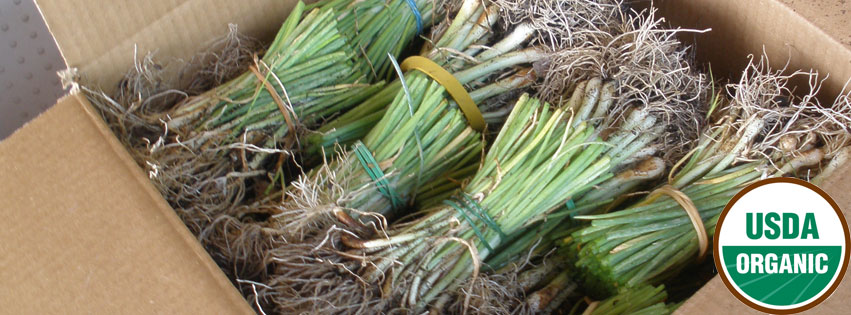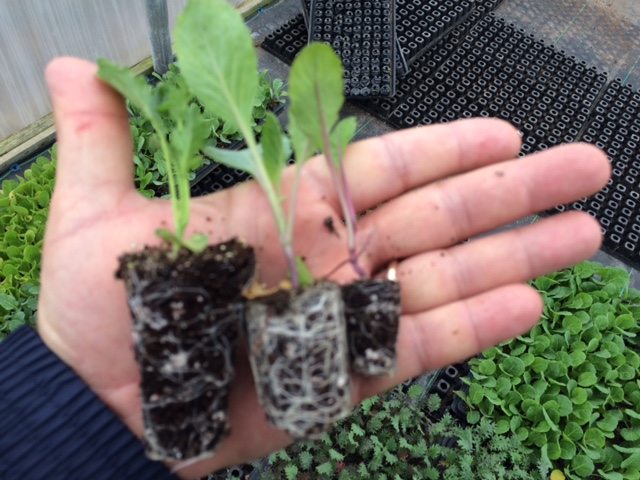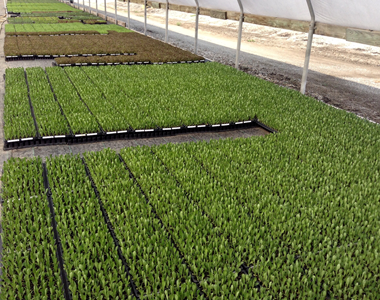by Gena Moore, CFSA’s Organic Research Coordinator
 Photo from Windcrest Farm’s Facebook page
Photo from Windcrest Farm’s Facebook page
All farmers and gardeners must make the decision whether to grow their own or purchase transplants. This decision is made considering several factors, including equipment needs; supply needs; the number of transplants needed; time of year; and, of course, price. There are a few people out there who, against all odds, can generate beautiful transplants year-round without fancy equipment. From my experience, those people are few and far between. The rest of us are forced either to invest in a greenhouse or other supplies, to grow our own, or buy them and save ourselves the trouble of it all. Whatever decision you make, below are some tips to help you be successful.
Transplants in the Spring
In the spring, temperature and daylight hours are limiting factors in transplant production. Starting them indoors, whether in your house or a greenhouse, is a requirement. The earlier you want to go to the field or high tunnel, the more difficult they are to grow. Commercial greenhouses are most often equipped with efficient heating systems and grow lights to mitigate these limitations. Solar greenhouses can be a great resource, but low night temps, fluctuating day temps, and low daylight hours can stress plants. Whatever structure you use, close microclimate monitoring is needed to ensure plants receive adequate environmental conditions. Heat mats are another great tool for spring production. Heat mats help warm soil and can induce germination. Some crops benefit more from heat mats, like peppers. Cool-season crops typically do not need heat mats.

Photo from bannergreenhouses.com
Transplants in the Fall
Fall transplant production, without a commercial greenhouse, has a completely different set of limitations. If producing transplants outside, the plants are subject to high pest pressure, high disease pressure, and, in some cases, heat. Keeping a clean growing space can help fight disease issues, while careful daily observations will help identify insect pressure before too much damage occurs. Finally, growing transplants under a shade cloth can ease heat issues and help keep soils moist. Commercial greenhouses are equipped with cooling systems. This keeps the temperatures consistent and in the appropriate range for transplants. These structures are usually completely controlled environments and, therefore, have little disease or pest pressure.
Choosing the Right Starting Media
One factor that impacts both spring and fall transplant production, and was the recent focus of a class held at Lomax Farm, is soil. Soil, or starting media, is an influential part of transplant production. Water holding capacity, macro/microparticles, and nutrient levels are just a few soil qualities that are at play when growing transplants. Many certified organic and conventional starting mixes are available, and choosing the right one for your production can be difficult. The class at Lomax Farm, offered in partnership with Rowan-Cabarrus Community College, taught participants to discover the practical application and results of using many different kinds of seed starting mixes. Although no definitive results were found, each student could discover their personal preference in starting mixes through data collection and observational record-keeping. This type of on-farm research is the best way to decide which soil or starting mix to use.
Finding Organic Transplants for Sale
Finally, some decide to buy transplants. Buying is worry-free, time-saving, and in many cases, cheaper than growing them yourself. There are many conventional transplant suppliers across North and South Carolina. Certified organic transplants are a little more difficult to find. Talk to your neighboring organic farmers to see if they grow their own, sell some of what they grow, or have any recommendations on local sources. Many organic farmers may be willing to grow out extra transplants for willing buyers. Also, combining orders from larger suppliers can help save money, so making those connections can prove beneficial.

Photo from bannergreenhouses.com
Make sure you have somewhere to store transplants. In most cases, it may take 1-2 weeks to get all your transplants in the ground, so having a good holding area is important. Get your timing right. Most suppliers only take preorders, so knowing what you want and when you need it is necessary. And lastly, build a good relationship with your supplier. This makes placing orders, getting new or rare varieties, and just general transactions easier!
Below is a list of certified organic and sustainable transplant suppliers.
Banner Greenhouses, Nebo, NC
Sprout, Inc., Barnwell, SC, (803) 259-3486
Windcrest Farm, Monroe, NC
Sustainably Produced Transplants:
Country Farm and Home, Pittsboro, NC


